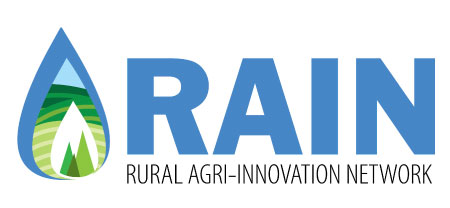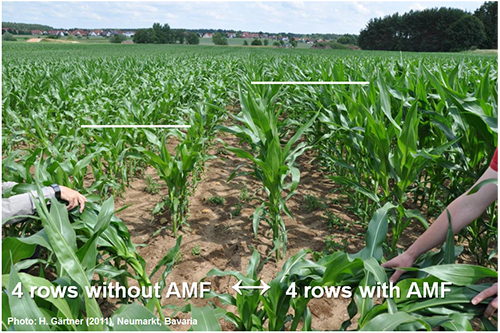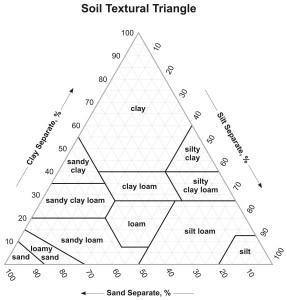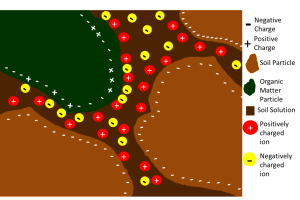Pasturing livestock, raising crops, and producing hay all rely on healthy, productive soils; however, encouraging your soil to be healthy and productive extends beyond the basic manure and lime applications. Relevant to all farming operations, understanding the soil as a living organism is an agricultural philosophy that has come to produce ecological, production-based, and profitable results for those who practice. Understanding these ecological principles as applied to crop- and pasture-based farming helps to reduce soil erosion and restore nutrient balances to the soil post-harvest. Good land-use management brings reduced costs in field maintenance, and improved soil structure and crop yields throughout the years.
Soil Health¹
There are two basic approaches of understanding the soil of your property, reductionist and integrated, and both approaches are used to develop fields that work at their optimum capacity. The reductionist approach breaks down the soil into measurable components such as pH, composition, texture, and nutrient levels. The integrated approach recognizes that soil health is also dependent on dynamic processes (e.g., seasonal effects on changes in soil microbe populations) and holds the assertion that soil health emerges through processes which are more than just the sum of its constituent parts. It is the interactions between reductionist and integrated soil processes, in combination with the local climate and sustainable farming practices, which produce a healthy soil.
Soil composition and texture²
The non-biological portion of soil (texture) is classified according to three main types of particle sizes, clay (≤ 0.002 mm), silt (0.002 – 0.05 mm), and sand (0.05 – 2.0 mm). The basic texture of your soil will impact its ability to retain nutrients and water and to make those available for plant uptake. Soils with smaller particle sizes (e.g., clay) have more ability to store nutrients due to the increases in surface area; however, drainage is likely to become an issue as water will move more slowly due to the density of particles per unit area.
Alternatively, soils with a high sand content will have better drainage and water distribution ability but will be more inclined to lose nutrient content because of the increased porosity. Loam soils are classified as an equal mixture of all three particle sizes and exhibit drainage and nutrient retention properties different from the other three classes (i.e., loam is an example of how new characteristics can be formed from more than just the sum of its parts; Figure 1).
Soil retention of nutrients³
The amount of organic matter in the soil will also affect the distribution and retention of resources. Humus and other forms of highly digested organic matter (e.g., compost, manure) have the chemical ability to retain mineral nutrients within the soil independently of the soil particulates themselves (ion exchange capacity; Figure 2). In a similar idea to a water softener, soil particles with a negative charge can trap positively-charged ions like calcium in the soil; additionally, soil particles with a positive charge can trap negatively-charged nutrients like phosphates and nitrates. Organic matter in the soil can trap nutrient ions to a greater degree than the soil particles themselves because of the abundance of positive and negative charges found in bio-molecules. The ion exchange capacity of a soil can be increased through the addition of organic matter and the cultivation of a permanent and thriving soil ecosystem; over time, this practice will lead to a rich layer of humus. It should be noted that exchange capacity does not inherently mean that the ions are available to plants as soil pH is a determining
factor for solubility. However, those ionic nutrients which are in a soluble form, as opposed to being sequestered or locked away in a mineral form like rock phosphate (apatite), are readily available to be used by plants and other soil inhabitants. The ionic nutrients and biomolecules that are released into the soil solution through the decomposition of crop residues and manure application help to keep other minerals and nutrients from being leached. Yet, in highly disturbed soil practices, the bio-molecules too, can be lost through erosion.
Soil aggregation and stability
One of the best and most easily accessible measures of overall soil health and quality is aggregate stability; another example of a healthy soil being more than the sum of its parts. Aggregates are the small ‘balls’ of soil that give soil its tilth, porosity, and water-holding capacity; they are an emergent property of a healthy soil ecology, and are produced when multiple soil particles become bound together. Stable soil aggregates are able to withstand disintegration in water and resist wind erosion; a loss of aggregate stability is often an early warning sign of changes in soil health. What holds these soil particles together in an aggregate is a combination of the bio-molecules produced through decomposition, fungal distribution networks, and secretions from plant roots and soil microbes (Figure 3).
Nitrogen-fixing bacteria living within root nodules and the rhizosphere (soil influenced by roots) of legumes are one of the reasons why these species are so important to farming. Yet, there are several species of nitrogen-fixing bacteria that live within soil aggregates that are formed with non-legume roots. These small (2-5 mm) aggregates act as a housing/support structure for the host of bacterial and fungal communities that enhance the growth of your crops. Non-legume species can help to restore depleted soil nitrogen, but only when the microorganisms can establish themselves inside of the aggregates.
Better than dirt
The fungi, bacteria, micro-invertebrates, and insects inhabiting your soils keep it alive and healthy and their proper functioning as a crop-supporting ecosystem is dependent on a stable working environment. Industrially, the past fifteen-years has seen productive shifts away from annual tillage; there are clear benefits to tilling, particularly when creating new fields, remedying compacted soils (e.g., aeration, nutrient mixing), or drying wet fields. However, frequent tillage disrupts soil ecology, severs microbial nutrient distribution networks and exposes surface soils to the elements; over decades, this large-scale disruption is a major source of nutrient loss and reduced moisture holding capacity. Soil disruption is particularly detrimental to mycorrhizal fungal networks.
Arbuscular mycorrhizal fungi (AMF; see photo) are a group of fungi which form symbiotic relationships with their host plants; in exchange for sugars produced by the plant through photosynthesis, the fungi provide the plant with phosphorous, nitrogen, and other micronutrients from the soil. It has been estimated that up to 80% of the World’s plants are mycorrhzial. The ability of the fungi to uptake nutrients from the soil greatly exceeds the plants own abilities, and maintaining these microscopic distribution networks results in higher yields and better performance (Figure 4).
Preparing your soil – rethinking definitions4
It has long been common practice to rotate crop species in order to replenish lost nitrogen, develop soil structure, and prevent erosion. Crop rotation is a natural and productive way to prevent insect and disease outbreaks by limiting the extent and duration of monoculture crops in a single area. By not rotating crops, farmers face increasing risks from pests; a re-emerging and detrimental practice of consecutively planting soya bean crops has lead to the increased spread of
soybean cyst nematode2 in areas of Southern Ontario. Species diversity is a good measure to protect against outbreaks of pests in addition to rotating crops. The use of nutrient-restoring cover crops after a harvest is an excellent way to prevent soil and nutrient loss over the years (Figure 5). Underseeding a crop with a late-germinating species, or planting a low-growing species like red clover, are excellent ways to preventing soil exposure to the elements.
J. Boudreau, Author
Research Note – Soil Health and its Importance to your Farm – Final PDF
Sources
1. Kibblewhite et al., 2008. Soil health in agricultural systems. Philos Trans R Soc Lond B. 363 (1492): 685-701.
2. Soil Textural Triangle. Natural Resources Conservation Service. United States Department of Agriculture. http://www.nrcs.usda.gov/Internet/FSE_MEDIA/nrcs142p2_050242.jpg
3. Plant Nutrition and Soils. New Zealand Institute of Chemistry. http://nzic.org.nz/ChemProcesses/soils/2A.pdf
4. Ontario Ministry of Agriculture, Food and Rural Affairs. Agronomy Guide for Field Crops – Publication 811. http://www.omafra.gov.on.ca/english/crops/pub811/8building.htm






